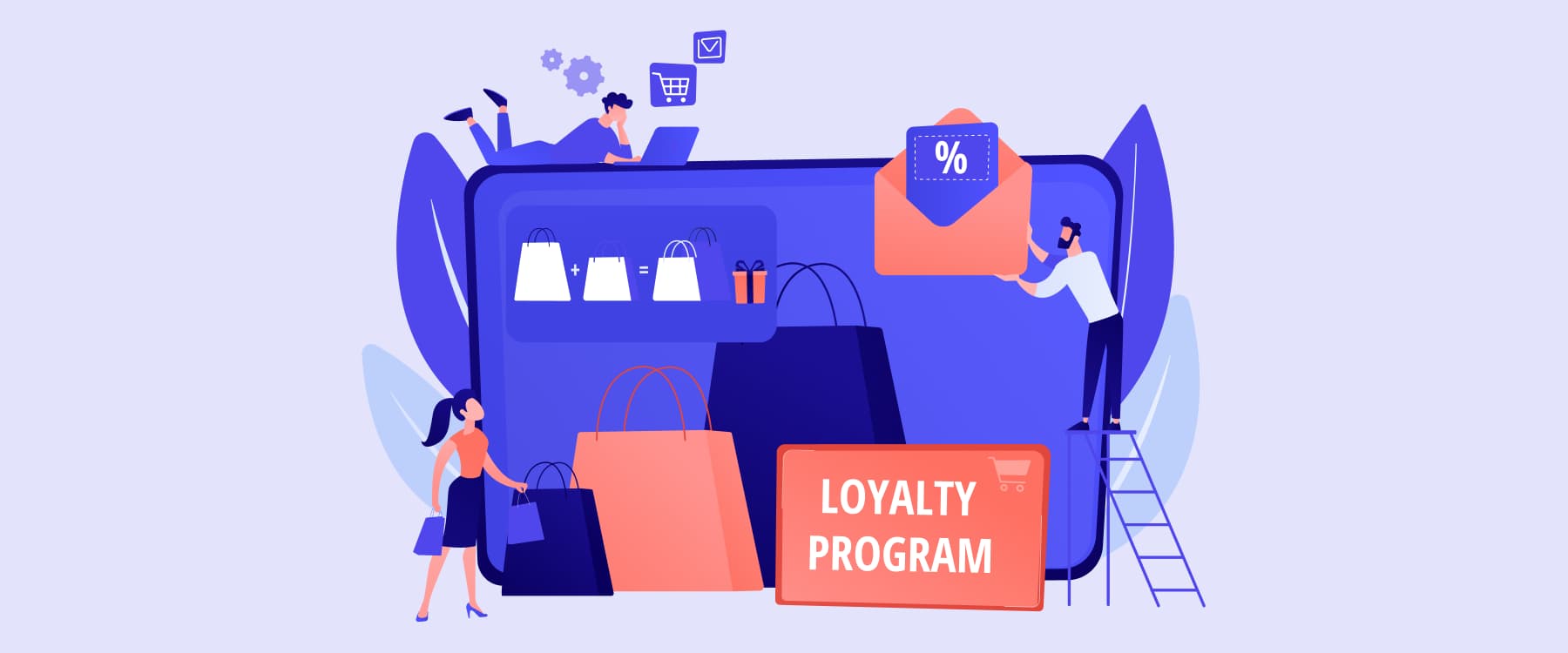Modern types of loyalty programs have evolved far beyond simple punch cards and basic point accumulation.
Different industries approach loyalty differently. Retail sectors might emphasize immediate transactional rewards, while service-based businesses could prioritize experiential benefits. Financial institutions often implement tiered membership structures that unlock progressively sophisticated perks.
But still some industries couldn’t figure out which loyalty program suits them the best. Now let us explore different types of loyalty programs, their key characteristics, real-world examples, and how each can be tailored to suit your industry’s specific goals.
Increase your ROI upto 20X using WPLoyalty’s pre-built loyalty campaigns and rewards your customers with points and discounts.
Types of loyalty programs
The 6 best types of loyalty programs are:
- Points-Based Loyalty Programs
- Tiered Loyalty Programs
- Cashback Loyalty Programs
- Subscription-Based Loyalty Programs
- Referral Loyalty Programs
- Gamified Loyalty Programs
1. Points-Based Loyalty Programs
Points-based loyalty programs, often referred to as “Earn and Redeem” systems. Customers earn points for specific actions, typically making purchases. Over time, these points accumulate and can be exchanged for rewards like discounts, freebies, or exclusive offers.
The key characteristic of points-based programs is their transactional nature. They are designed to directly link a customer’s spending with tangible benefits.
The simplicity of the system ensures that it’s easy for both businesses and customers to understand, track, and use.
Reward points also act as a psychological motivator, encouraging customers to spend more to “unlock” rewards, which boosts their average order value.
Does it Fit Your Industry?
Points-based loyalty programs work especially well for industries with high purchase frequencies or transactional volumes, such as retail, eCommerce, or food and beverage.
Industries offering affordable, everyday products—like groceries or coffee shops—benefit greatly from point systems since customers see immediate, tangible returns.
For SaaS or subscription-based businesses, points-based systems can also work if tied to engagement metrics (e.g., completing tasks, referring friends) to drive regular usage or renewals.
Example: Nordy Club lets you earn 1-3 points per $1 spent, depending on your payment method and status. Points convert to Nordstrom Notes, redeemable for purchases: 1,000 points = $10; 2,000 points = $20.
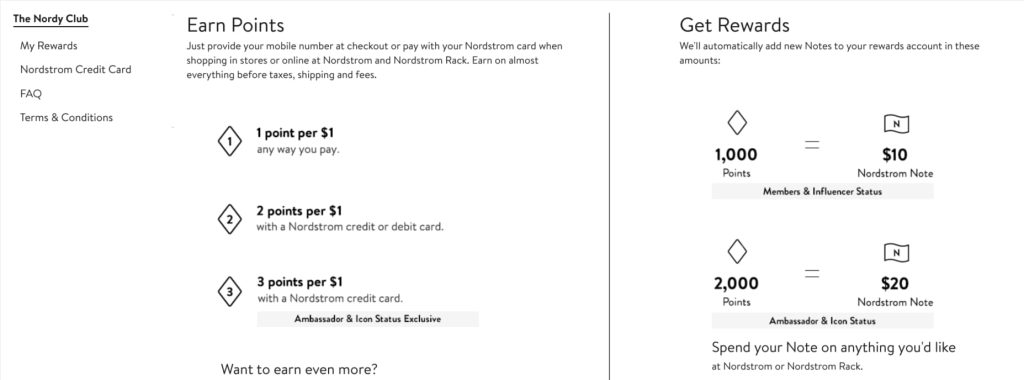
Best Practices to Implement a Points System
- Make the point-to-reward conversion straightforward, such as 1 point for every $1 spent.
- Allow customers to start redeeming rewards with smaller point thresholds.
- Use a loyalty software platform that tracks points and redemption.
- Create urgency by setting point expiration dates.
2. Tiered Loyalty Programs
Tiered loyalty programs create a structure where customers move through different levels or tiers based on their spending or engagement. As they progress, they unlock increasingly valuable rewards, benefits, or privileges.
Tiered programs are hierarchical and aspirational. Typical tier structures include:
- Entry-Level Tier: Basic rewards and minimal benefits
- Mid-Level Tier: Enhanced perks and personalized experiences
- Premium Tier: Exclusive benefits and VIP treatment
- Elite/Top Tier: Highest level of brand recognition and extraordinary privileges
Does it Fit Your Industry?
Tiered loyalty programs are especially effective in industries where customer loyalty is critical and spending patterns vary significantly. They work well for:
- Luxury or premium brands: Encourage customers to spend more to access exclusive perks.
- eCommerce and retail: Boost order frequency and value with tier-based rewards.
- Travel and hospitality: Airlines and hotels use tiers (e.g., silver, gold, platinum) to reward frequent travelers with VIP benefits.
- Subscription services: Offer tiered rewards based on tenure or engagement to reduce churn.
Example – Sephora’s Beauty insider program offers tiered benefits: Insider (free), VIB ($350/year), and Rouge ($1,000/year). Members earn escalating points for purchases, enjoy discounts, free gifts, and exclusive perks like first access to products and special events.
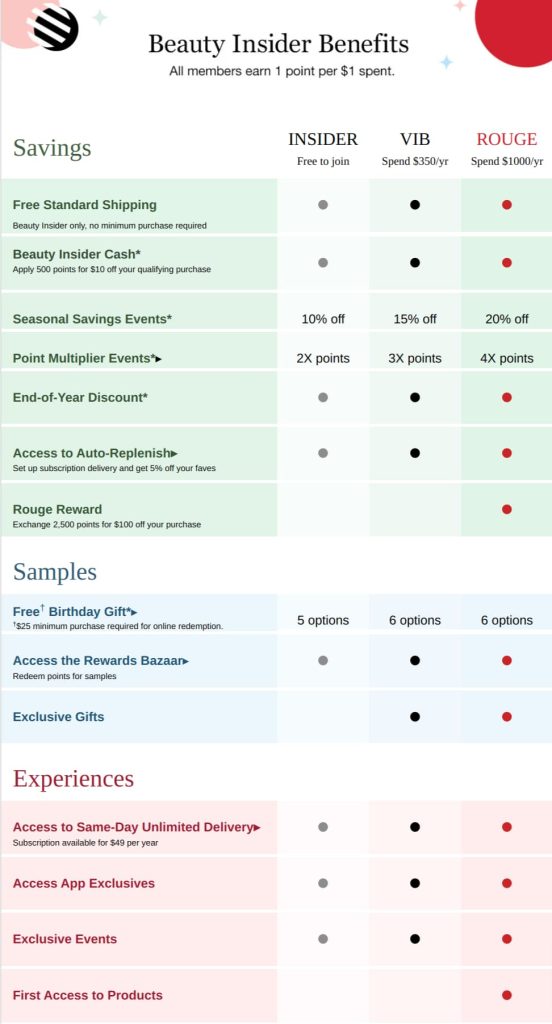
Best Practices to Implement a Tiered Loyalty Program
- Start small with two or three tiers and scale as customer engagement grows.
- Set clear milestones for advancing to the next level (e.g., spend $500 to move to Silver).
- Ensure that rewards in higher tiers feel exclusive and worth the effort.
- Use visuals, badges, or progress bars to make tier advancement exciting.
Create a multi tiered loyalty program with WPLoyalty’s easy-to-use campaign and encourage your customers with escalating rewards.
3. Cashback Loyalty Programs
Cashback loyalty programs reward customers with a percentage of their spending returned as cash or store credit.
Loyalty systems with cashbacks are monetary-based. It provides a direct financial benefit, making it one of the most transparent and easy-to-understand loyalty models.
Does it Fit Your Industry?
Cashback programs are ideal for industries where financial savings are a strong motivator. They work particularly well in:
- Retail and eCommerce: Encourages repeat purchases and increased cart value.
- Banking and Fintech: Many credit cards use cashback rewards to incentivize card usage.
- Travel and hospitality: Provides value for frequent travelers booking flights or hotels.
- Subscription services: Offers subscribers a way to justify continued spending.
Example – Rakuten is a prime example of a cash back loyalty program done right. Customers earn a percentage of their purchases as cashback when they shop through Rakuten’s platform at partner stores. The cashback is either deposited into their accounts or sent as checks.

Best Practices to Implement a Cashback System
- Keep the cashback rate straightforward, like 5% on all purchases or higher rates for specific categories.
- Allow customers to use their cashback for future purchases, withdraw it as cash, or apply it to their next bill.
- Promote special events or products where customers earn extra cashback.
4. Subscription-Based Loyalty Programs
Subscription-based loyalty programs offer customers exclusive benefits in exchange for a recurring payment, typically on a monthly or annual basis.
A subscription loyalty program is recurring by design, offering customers continuous value over a set period. Rather than earning points or cashback from individual transactions, customers pay upfront or on a regular schedule to gain access to a range of rewards, products, or services.
Does it Fit Your Industry?
Subscription-based loyalty programs work well in industries where customers benefit from long-term access to products or services. They are especially effective in:
- Digital services and SaaS: Companies offering software subscriptions (e.g., Netflix, Adobe) create recurring revenue streams and deeper user engagement.
- Retail and eCommerce: Subscription boxes (e.g., beauty boxes, meal kits) are ideal for recurring shipments and surprise product discoveries.
- Media and Entertainment: Platforms like Spotify and Amazon Prime use subscription models to offer entertainment, shopping benefits, and exclusive deals.
- Fitness and Wellness: Gyms, yoga studios, and health-related services thrive with monthly or annual membership models.
Example – Coldwater Creek’s “MyColdwater Rewards program” is a great example of a subscription-based loyalty model. For a fee of $16.99 per month, members receive exclusive cashbacks, rebates on shipping, and more.
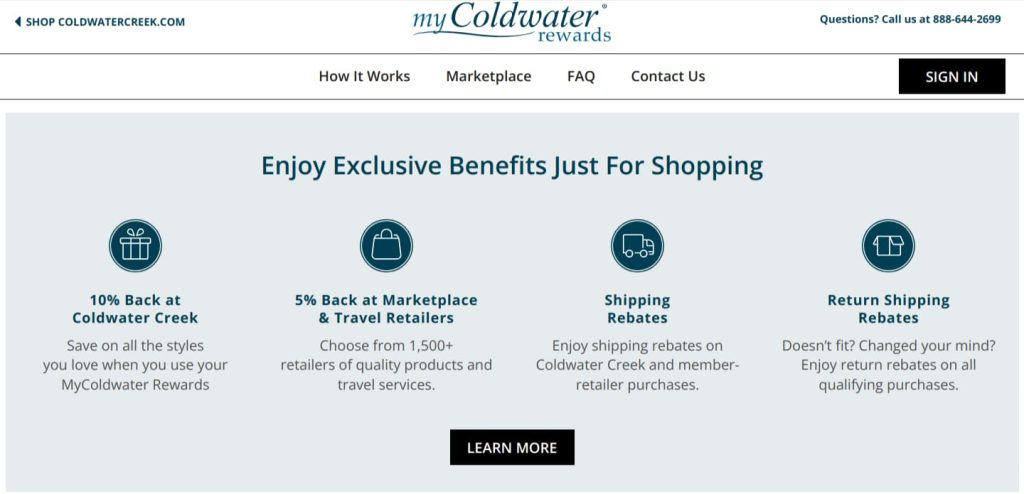
Best Practices to Implement a Subscription-Based Loyalty Program
- Provide different levels of subscriptions (e.g., basic, premium, VIP).
- Ensure that the benefits customers receive justify their subscription fees.
- Make subscribing and managing loyalty membership easy for customers.
5. Referral Loyalty Programs
Referral loyalty programs are built around the idea of rewarding customers for acquiring new customers to your business.
They capitalize on word-of-mouth by offering incentives for referring friends, family, or colleagues. It is great for both customer acquisition and retention.
Referral programs are social in nature. The program typically works by providing a unique referral link or code to existing customers. When someone uses that link or code to sign up or make a purchase, the referrer gets a reward, and the new customer may receive an incentive as well.
Does it Fit Your Industry?
Referral programs work well across a variety of industries, especially where customers are likely to trust personal recommendations. They are most effective in:
- eCommerce and Retail: Existing customers refer others to the store, especially for items that make great gifts or purchases.
- SaaS and Digital Services: Software companies offer referral programs where users bring in new sign-ups in exchange for account upgrades or free months of service.
- Food and Beverage: Many food delivery services or subscription box services create referral programs to get their users to share with friends and earn credits or discounts.
- Health and Fitness: Referral programs work well in gyms or wellness services, where friends are likely to encourage each other to join.
Example – Dropbox’s referral program is a classic and highly successful example of a referral loyalty program. Dropbox offers free storage space to both the referrer and the referred person when the referral signs up for an account.
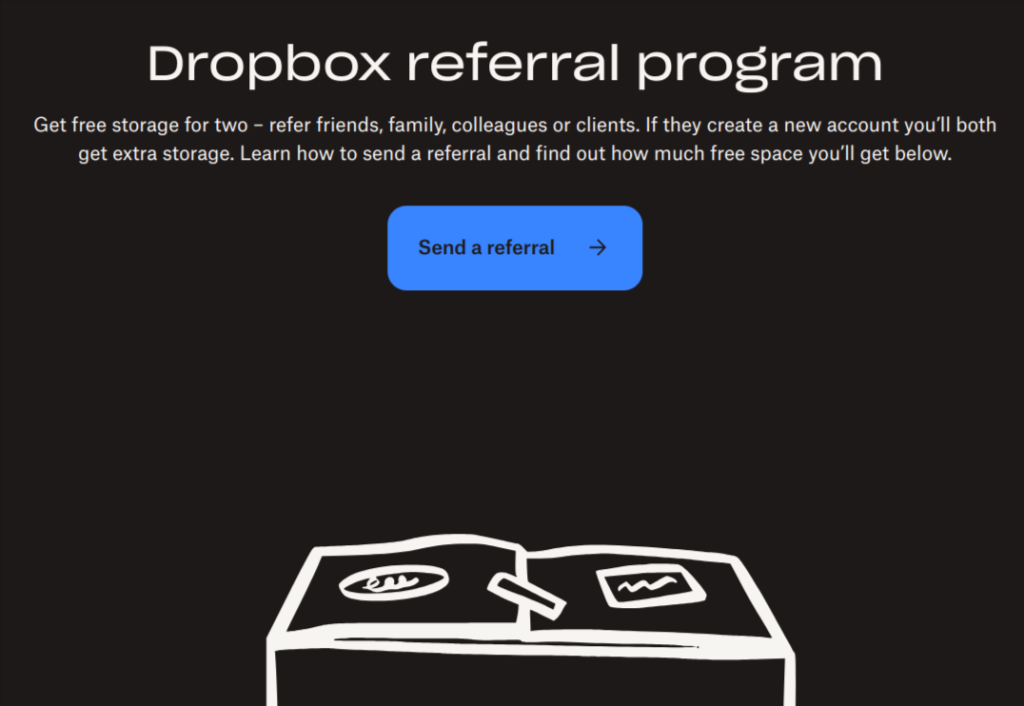
Best Practices to Implement a Referral Loyalty Program
- Make the referral process easy to understand.
- Make sure the rewards for both the referrer and the new customer are appealing enough to encourage participation.
- Use the best referral plugins with multiple reward types for both referrers and referees.
- Use social media, customized emails, and your website to promote the referral program.
- Encourage your referrers to share why they love your product.
Set up a referral program and reward both referrers and referees with multiple reward types like points, discounts, free shipping and freebies using WPLoyalty.
6. Gamified Loyalty Programs
Gamified loyalty programs integrate game-like elements such as challenges, points, levels, badges and more.
It offers a dynamic and interactive experience. These programs are particularly effective at addressing customer pain points like lack of engagement or perceived monotony in traditional loyalty schemes.
These programs typically involve elements like:
- Points: Customers earn points for actions such as making purchases, referring friends, or engaging with content.
- Badges: Digital badges are awarded when customers hit milestones, such as making a certain number of purchases or reaching a spending goal.
- Leaderboards: Showcasing top customers on a leaderboard can create a competitive environment, motivating users to climb the ranks and earn additional rewards.
- Challenges or Quests: Setting specific goals or challenges (e.g., “Buy 3 items this week”) encourages customers to complete tasks for rewards.
- Levels: Customers can level up as they engage more with the brand, unlocking higher-tier rewards or exclusive offers.
Example – Cedar Fort, a publisher and retailer of books, gifts, and home decor, utilizes a “spin to Win” gamified loyalty program to reward their customers.
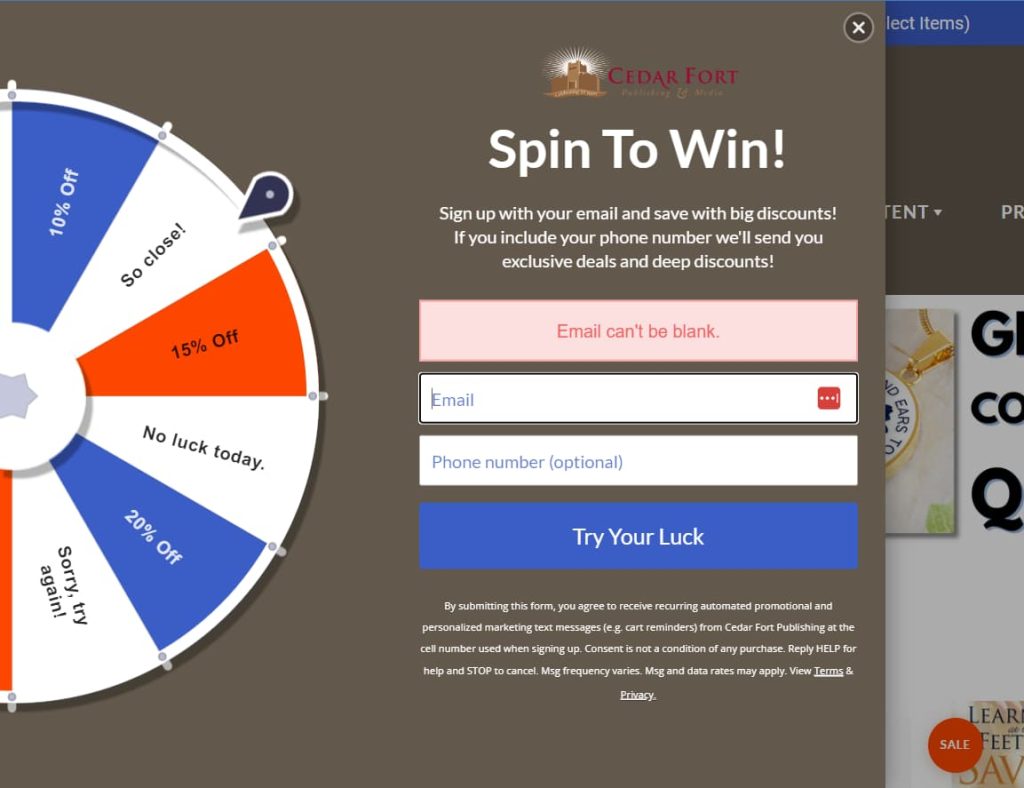
Best Practices to Implement a Gamified Loyalty Program
- Offer rewards that are valuable but also achievable.
- Don’t overcomplicate the gamified experience.
- Allow customers to compare their progress with others through leaderboards or social sharing.
- Clearly display their progress—whether it’s through points, levels, or badges.
Get started with WPLoyalty’s pre-built loyalty campaigns and reward your customers for purchases, sign up, referrals, reviews, birthday, achievements and more.
Wrapping Up
Loyalty programs have evolved far beyond simple punch cards and transactional rewards.
The six loyalty program types we’ve explored – Points-Based, Tiered, Cashback, Subscription-Based, Referral, and Gamified – demonstrate the incredible versatility of modern customer retention strategies.
Key Takeaways:
- No single loyalty program fits all businesses
- Successful programs require deep understanding of customer motivations
- Technology and personalization are driving loyalty program innovation
- Flexibility and customer-centric design are critical
Frequently Asked Questions
The 3 R’s of loyalty are Reach, Reward, and Retention. These refer to attracting customers, rewarding their behavior, and retaining them long-term.
Some of the most successful loyalty programs include Starbucks Rewards, Amazon Prime, and Sephora Beauty Insider, known for their simplicity, exclusivity, and personalized rewards.
The five criteria are: Clear value proposition, Ease of use, Attractive rewards, Personalization, and Effective communication.
The strongest form of brand loyalty is emotional loyalty, where customers feel deeply connected to the brand beyond just its products or services.
Rewards programs focus on providing incentives for specific actions (e.g., purchases), while loyalty programs aim to build long-term relationships through consistent engagement and rewards.
